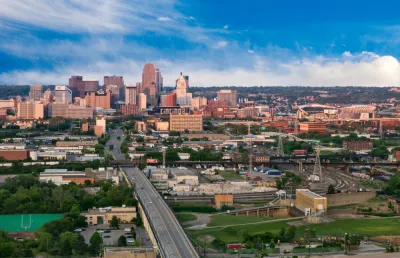Identifying potential hubs and activity centers allows regions to foster economic growth and density.

"To be economically competitive, state, regional, and local leaders need to align their infrastructure, economic development, and land-use policies to support and grow concentrations of activity, rather than encourage sprawl," write Tracy Hadden Loh and Joanne Kim.
Economic mapping is a strategy that looks at areas based on a range of key measures to bring together regional planning and strategized economic development. In Cincinnati, for example, Plan Cincinnati is a guide for future planning:
Twelve working groups examined the city’s assets and opportunities around key elements ranging from arts and culture to fiscal impact, governance, and infrastructure. Based on the findings, the city mapped existing and potential activity centers and now prioritizes its resources to support their growth.
Loh and Kim discuss other economic mapping efforts in Portland, Oregon, Northeast Ohio, and Washington, D.C. "Far more cities and metro areas need to better coordinate their strategies for increasing the quality of existing concentrations of activity, and expand investments into places with potential to become such hubs," they say.
FULL STORY: ‘Economic mapping’ can help cities target the best places for density and growth

National Parks Layoffs Will Cause Communities to Lose Billions
Thousands of essential park workers were laid off this week, just before the busy spring break season.

Retro-silient?: America’s First “Eco-burb,” The Woodlands Turns 50
A master-planned community north of Houston offers lessons on green infrastructure and resilient design, but falls short of its founder’s lofty affordability and walkability goals.

Delivering for America Plan Will Downgrade Mail Service in at Least 49.5 Percent of Zip Codes
Republican and Democrat lawmakers criticize the plan for its disproportionate negative impact on rural communities.

Test News Post 1
This is a summary

Test News Headline 46
Test for the image on the front page.

Balancing Bombs and Butterflies: How the National Guard Protects a Rare Species
The National Guard at Fort Indiantown Gap uses GIS technology and land management strategies to balance military training with conservation efforts, ensuring the survival of the rare eastern regal fritillary butterfly.
Urban Design for Planners 1: Software Tools
This six-course series explores essential urban design concepts using open source software and equips planners with the tools they need to participate fully in the urban design process.
Planning for Universal Design
Learn the tools for implementing Universal Design in planning regulations.
EMC Planning Group, Inc.
Planetizen
Planetizen
Mpact (formerly Rail~Volution)
Great Falls Development Authority, Inc.
HUDs Office of Policy Development and Research
NYU Wagner Graduate School of Public Service



























